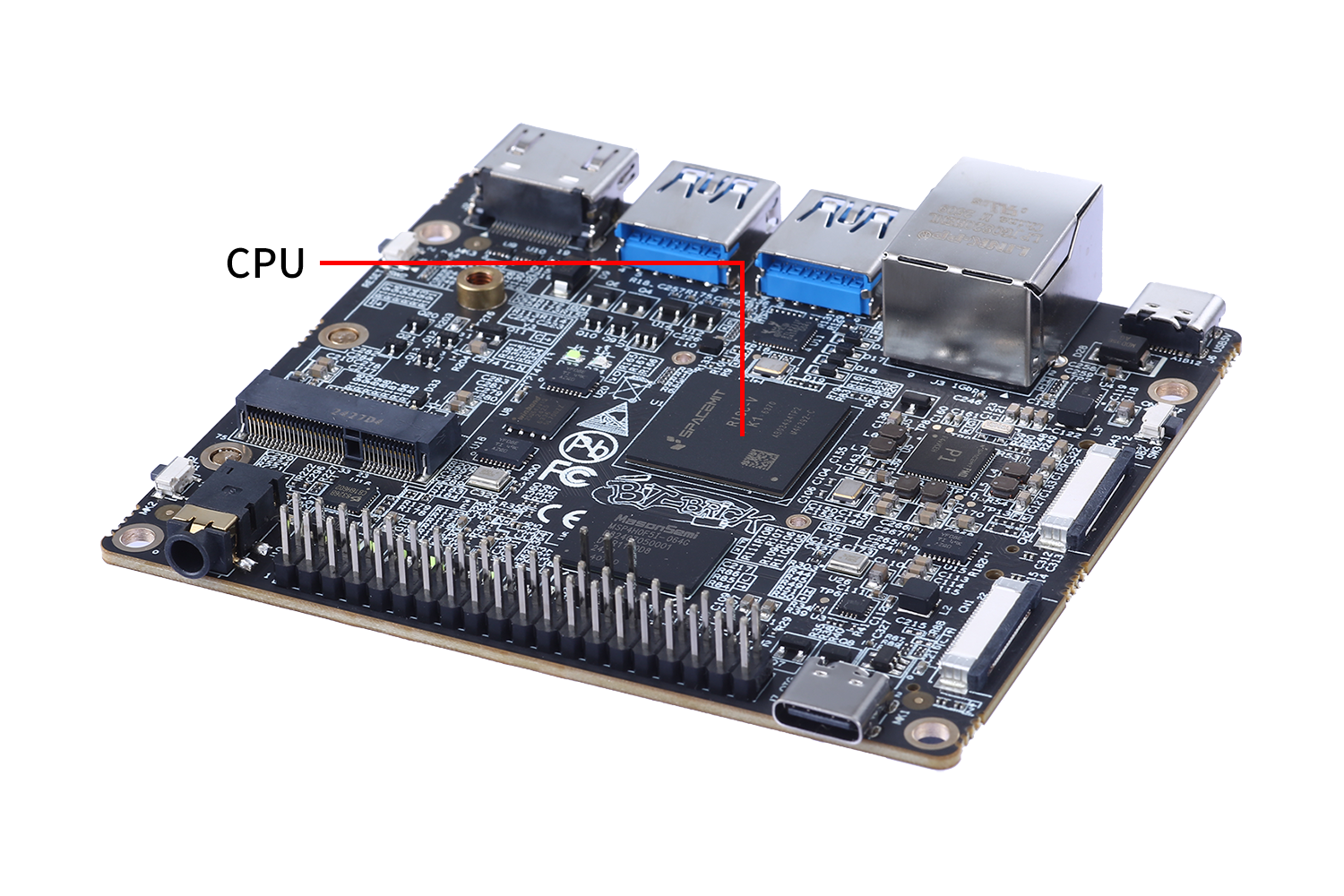Product Overview
1. Product Introduction
SpacemiT® Key Stone™ K1 is a high-performance and ultra low-power SOC that integrates Octa RISC-V CPU cores with SpacemiT® Daoyi™ AI computing power deployment. K1 has the following features:
- Integrates SpacemiT® self-innovate X60™ RISC-V processor core which adheres to the RISC-V 64GCVB architecture and RVA22 standard.
- Extends 2.0TOPS AI computing power by exploring RISC-V customized instructions to realize CPU AI fusion computing power, and mainstream AI inference frameworks such as TensorFlow Lite, TensorFlow, and ONNX RunTime are supported.
- Achieves ultra low power consumption by implementing different granularities of power islands and various levels of power states to make K1 more competitive and the leading edge.
- Supports full-feature interfaces to enrich more innovatative applications and products.
- Compatible with mainstream OS to meet the needs of various application scenarios.
- Meets Industrial grade reliability standards

2. Feature Overview
Application Processor
- RISC-V SpacemiT® X60™ Dual-Cluster Octa-core processors
- Adhere to the RISC-V 64GCVB architecture and RVA22 standard
- Cluster0
- Quad-Core with 2.0TOPS AI-Power
- 32K L1-Cache per core
- 512K L2-Cache
- 512KB TCM
- Vector-256bit
- Cluster1
- Quad-Core
- 32K L1-Cache per core
- 512K L2-Cache
- Vector-256bit
- DVFS with adaptive operating voltage from 0.6V to 1.05V DDR Memory
- Dual chip select 32-bit LPDDR4/LPDDR4x SDRAM with 2666Mbps operation and a total of up to 16GB of RAM
- Dual chip select 32-bit LPDDR3 SDRAM with 1866Mbps operation and a total of up to 4GB of RAM RCPU(Real-Time CPU)
- R-I2C (×1)
- R-I2S (×2)
- R-UART (×2)
- R-CAN_FD (×1)
- R-IR_RX (×1)
- R-PWM (×10)
- R-SPI (×1) Peripheral Controller
- GPIO (×128)
- 128 pins
- Pull-up/pull-down programmable
- 104x 1.8V IO8
- 24x 1.8V/3.3V IO
- UART (×10)
- AP/BT/print
- I2C (×10)
- for camera, G-Sensor/ E-COMPASS/ Proximit-Sensor/ Light-Sensor/Gyro and Fingerprint/NFC, PMIC, touch etc.
- 8x AP_I2C(AP I2C0/1/7 only for camera)+1x HDMI I2C+1x PWR I2C
- SPI (×4)
- To support both master and slave mode
- For IMU, codec etc.
- Platform has 4 SPI (1x QSPI, 1x SPI LCD, 2x SPI)
- USB (×3)
- USB 2.0 OTG
- USB 2.0 Host
- USB 3.0 (combo PCIE PortA)
- PCIE (×3)
- PCIE PortA Gen2x1
- PCIE PortB Gen2x2
- PCIE PortC Gen2x2
- GMAC (×2)
- 10/100/1000 Mbps
- RGMII
- SDIO (×1 for WIFI)
- compatible for 4-bit SDIO 3.0 UHS-I protocol, up to SDR104 (208MHz)
- SD (×1 for TF card)
- compatible for 4-bit SD 3.0 UHS-I protocol, up to SDR104 (208MHz)
- eMMC (×1)
- compatible for 8bit eMMC5.1, up to HS400 (200MHz)
- MIPI CSI (CSI-2 v1.1) 4 lane(×2)
- 4 Lane + 4 Lane mode
- 4 Lane + 2 Lane mode
- 4 Lane + 2 Lane + 2 Lane mode (triple sensor)
- MIPI DSI (DSI v1.1) (×1)
- 4 Lane DSI
- PWM (×20)
- CAN-FD (×1)
- IR-RX (×1) Security System
- RISC-V PMP Security
- Secure Boot
- Secure eFuse 4K bits
- Cryptographic engine (TRNG/AES/SM2/SM3/SM4/RSA/ECC/SHA2/HMAC) Debug System
- Two JTAGs for both CPU and MCU subsystem
- UARTs
- CPU/IO register snapshot after watchdog reboot Boot System
- Initial AP boot from SPI-Nand/SPI-NorFlash/eMMC/SD
- 128KB boot-ROM size Aided System
- Watchdog design for each CPU/MCU subsystem Multimedia Features GPU
- IMG BXE-2-32@819MHz, 32KB SLC
- Support OpenCL3.0/OpenGL ES 3.2/Vulkan1.3 VPU (video processing unit)
- H.265/H.264/VP8/VP9/MPEG4/MPEG2 decoder 4K@60fps
- H.265/H.264/VP8/VP9 encoder 4K@30fps
- Support simultaneously processing encoding 1080P@60fps and decoding 1080P@60fps
- Support simultaneously processing H264/H265 encoding 1080P@30fps and H264/H265 decoding 4K@30fps Display
- 1 MIPI DSI-4lane or SPI interface
- Support up to HD + (1920x1080@60fps)
- Support up to 4-full-size-layer composer and maximum 8 layer composer by up-down layer reuse in rdma channel
- Support cmdlist mechanism, which can configure register parameters by HW
- Support concurrent write back, with both raw and afbc format, also support dither/crop/rotation in write back path
- Support advanced mmu (virtual address) mechanism, with nearly no page missing in 90/270 degree rotation
- Support color key and solid color
- Support both advanced error diffusion and pattern based dither for panel
- Support both afbc/raw format image source
- Color saturation/contrast enhancement
- Support both video mode and cmd mode for panel
- Support ddr frequency dynamic changing with embedded dfc buffer HDMI 1.4 Camera
- Dual-ISP
- 16M (max.) 30fps Dual ISP
- One 4 Lane CSI + one 4 Lane CSI or 4 Lane + 2 lane + 2 lane
- RAW sensor, output YUV data to DRAM
- Hardware JPEG encoder(hardware, up to 23M is supported)
- Support YUV/EXIF/JFIF format
- AF/AE/AWB
- Face detection
- Digital zoom, panorama view
- PDAF
- PIP (picture in picture)
- Continuous video AF
- HW 3D denoise Audio
- Integrated high quality audio codec and audio front-end
- ADC: 90dB SNR@20~20kHz
- DAC: 95dB SNR@20~20kHz
- Class-G: 95dB SNR@20~20kHz, 31mW@32-ohm, THD -90dB
- ClassAB: 95dB SNR@20~20kHz, 75mW@32-ohm, THD-90dB
- Line-out to support external Class-D audio amplifier (Class-D in PMIC: 95dB SNR@20 ~ 20kHz, 1W@4.2Vbat 10%THD + N, 8-ohm speaker)
- Three MICs input
- Stereo inputs path for noise cancellation
- Stereo headphone output
- Audio content sampling rates: 8kHz to 48kHz
- Microphone bias for headphone plug-in and hook-key detection
- Quad vocoders for adaptive multi-rate (AMR)
- Noise suppression and echo cancellation General
- Operation temperature: -40 ~ 85°C
3. Block Diagram


